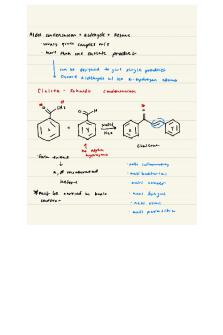Lab E Aldol Updated PDF

| Title | Lab E Aldol Updated |
|---|---|
| Author | Czarina Alfonso |
| Course | Introductory Organic Chemistry Laboratory |
| Institution | Johns Hopkins University |
| Pages | 2 |
| File Size | 92 KB |
| File Type | |
| Total Downloads | 91 |
| Total Views | 133 |
Summary
Aldol lab...
Description
Lab E: Aldol Condensation: Synthesis of 2,3,4,5Tetraphenylcyclopentadienone The ability to form carbon-carbon bonds is an important technique in organic chemistry. In the Grignard Lab, we formed C-C bonds by synthesizing triphenylmethanol from a Grignard Reagent. This week, we will employ a different method, the aldol condensation, to synthesize tetraphenylcyclopentadienone. The techniques used in this lab are ones with which you have become familiar throughout this course. By this point in the session, you should be able to read an experimental and go into lab having figured out the amounts of reagent and types of glassware that you need to use. Be sure you come to class prepared. In this reaction, a C-H bond in diphenylacetone is deprotonated, forming a carbon nucleophile that can then add to a ketone. The resulting alcohol may then be dehydrated. We will be performing a double aldol condensation with diphenylacetone and benzil using KOH as a catalyst. The resulting product, 2,3,4,5tetraphenylcyclopentadienone, is a highly colored molecule.
O Ph
O
O Ph
Ph
KOH, EtOH Ph
O
Ph
Ph
reflux Ph
Ph
Experimentally, it is necessary to use a solvent that will be able to solubilize both the base (in our case KOH) and the organic substrates (benzil and diphenylacetone). Furthermore, it is necessary that the solvent have a high enough boiling point that the reaction will occur at a reasonable rate at the reflux temperature. For this reaction, ethanol fulfills those criteria. Tetraphenyl cyclopentadienone (1): Benzil (2.0 grams, 1.0 equiv) and diphenylacetone (1.0 equiv) were dissolved in ethanol (40 mL) and KOH (0.45 g) was added. The mixture was refluxed 15-30 min until everything was dissolved. After cooling to 5 ºC, the crystals were collected by vacuum filtration, washed with ethanol (3×5 mL) and dried to give the product as dark purple crystals.
Before lab in your notebook: You need a title, a graphical drawing of the reaction, and a reagents table. The reagents table should include benzil, diphenyl acetone, and KOH (mass, molecular weight, mmoles, equivalents). You need to include the hazards of KOH, and the boiling point of ethanol.
Prelab Questions to be answered in your notebook: • What size flask should you use? What type of flask should you use? • What would happen if you started timing your reaction before the mixture was actually refluxing? • What color do you think the washing will be? What color will the crystals be? The following data MUST be recorded in your notebook. • The theoretical yield of tetraphenyl cyclopentadienone • The mass of tetraphenyl cyclopentadienone • The percent yield tetraphenyl cyclopentadienone. Study Questions (not to be answered in your notebook): • In this lab, KOH is used to deprotonate a C-H bond. Generally speaking, H atoms bound to carbons are not considered very acidic. Why is this C-H bond acidic enough to be deprotonated by KOH? • What causes color in organic compounds? • If your compound appears purple, approximately what wavelength of light does it absorb? • Does the equilibrium between KOH and diphenylacetone favor the deprotonated form?...
Similar Free PDFs

Lab E Aldol Updated
- 2 Pages

Aldol Condensation - lab report
- 4 Pages

Aldol Lab Report
- 12 Pages

Aldol Condensation Lab Report
- 7 Pages

Aldol Condensation - lab report
- 7 Pages

Aldol Condensation - Lab report
- 7 Pages

Aldol condensation - lab
- 9 Pages

Aldol and 9fluro - lab report
- 3 Pages

Aldol lab - Lecture notes 8
- 4 Pages

LAB 1 updated
- 5 Pages

Chem 344 lab 11 crossed aldol
- 6 Pages
Popular Institutions
- Tinajero National High School - Annex
- Politeknik Caltex Riau
- Yokohama City University
- SGT University
- University of Al-Qadisiyah
- Divine Word College of Vigan
- Techniek College Rotterdam
- Universidade de Santiago
- Universiti Teknologi MARA Cawangan Johor Kampus Pasir Gudang
- Poltekkes Kemenkes Yogyakarta
- Baguio City National High School
- Colegio san marcos
- preparatoria uno
- Centro de Bachillerato Tecnológico Industrial y de Servicios No. 107
- Dalian Maritime University
- Quang Trung Secondary School
- Colegio Tecnológico en Informática
- Corporación Regional de Educación Superior
- Grupo CEDVA
- Dar Al Uloom University
- Centro de Estudios Preuniversitarios de la Universidad Nacional de Ingeniería
- 上智大学
- Aakash International School, Nuna Majara
- San Felipe Neri Catholic School
- Kang Chiao International School - New Taipei City
- Misamis Occidental National High School
- Institución Educativa Escuela Normal Juan Ladrilleros
- Kolehiyo ng Pantukan
- Batanes State College
- Instituto Continental
- Sekolah Menengah Kejuruan Kesehatan Kaltara (Tarakan)
- Colegio de La Inmaculada Concepcion - Cebu




